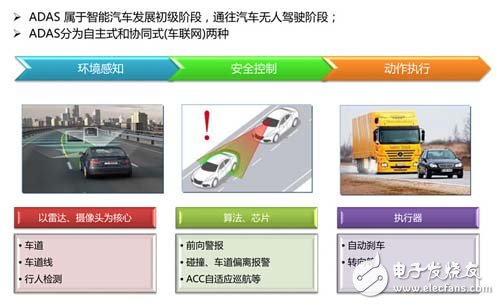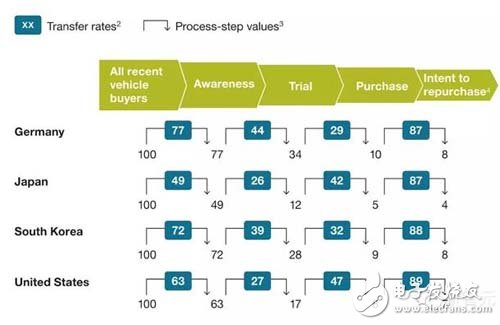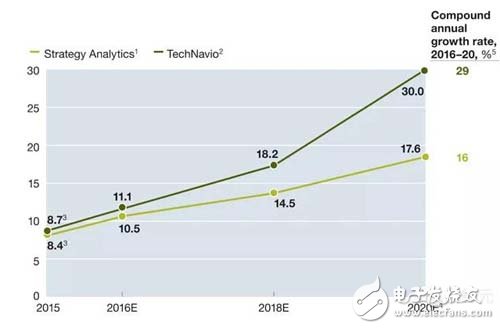McKinsey: ADAS driving will become the mainstream of car development
Semiconductor companies can take ADAS applications to the next level, but only if they are ready to embrace change.
Advanced Driver Assistance Systems (ADAS), primarily for monitoring, warning, braking, and steering tasks, are expected to grow in demand over the next decade, and safety measures to protect drivers and reduce accidents have regulatory requirements. And there are consumer concerns, both of which are the main drivers of this growth. For example, both the European Union and the United States mandate that all motor vehicles be equipped with autonomous emergency braking systems and forward collision warning systems by 2020. A recent McKinsey survey also shows that car buyers are increasingly interested in ADAS systems that offer features such as assisted parking systems or rear blind spot monitoring that are both comfortable and economical.

Although ADAS applications are still in the early stages of development, original equipment manufacturers (OEMs) and their suppliers have realized that these applications may eventually become the main function determining car brand differentiation and can be an important source of revenue. The technology used in today's ADAS systems can also be used to manufacture unmanned vehicles, and this area is precisely the focus of research and development that OEMs and high-tech companies, including Google, have recently entered the automotive arena. If a driverless car is on the market, vehicles that have adopted ADAS technology first will be in a good position.
Many semiconductor companies, including those traditionally not involved in the automotive sector, are now offering ADAS products or are developing such products. However, there is still a large market uncertainty for these new technologies. One of the factors is how do important driving functions such as computer control or auxiliary control guidance react to such advanced technology consumers? In the first part of this article, we will explore some of the most pressing issues related to ADAS, covering future needs, technical challenges, and competitive landscapes. The second part of this article will look at ADAS from a semiconductor company's perspective, exploring how the company can differentiate its competitors by directly extending its solutions beyond hardware, working directly with OEMs, and relying on security and protection features to differentiate its competitive advantage. Thereby achieving higher returns.
Future opportunities and challenges coexist
Although ADAS technology has the potential to change the automotive industry, according to multi-party estimates, the current annual sales in this field is between $5 billion and $8 billion, which is quite inconspicuous compared to other automotive systems. For example, sales of car audio and information systems in 2015 were about $30 billion, while in-vehicle environmental conditioning systems were about $60 billion. Part of the reason for this problem is that many ADAS application technologies are currently in the commissioning phase or are not yet available; others are expensive and are mainly used in high-end models. But one of the most important reasons for curbing demand may be the lack of consumer awareness. An online survey of 4,500 car buyers in five countries in McKinsey recently showed that many respondents were not familiar with ADAS technology, and only a few purchased vehicles were equipped with this technology (Figure 1). There is reason to be optimistic about the results of this survey, as the data shows that for those buyers who have purchased the ADAS system, the repurchase rate is very high, reaching 87% to 89%. This means that once consumers understand the ADAS system, they will prefer the models with these features.
Figure 1: Many car buyers lack understanding of advanced driver assistance systems

1. 4,500 car buyers from China, Germany, Japan, South Korea and the United States participated in the online survey.
2. Percentage of buyers who switch from one stage of the consumer decision process to the next stage
3. The percentage of all recent car buyers who reached a certain decision stage. Due to rounding, the addition of numbers may not be consistent with the total.
4. Includes purchasers who indicate that they will purchase or may purchase a car with an ADAS feature.
Source McKinsey & Company - Source: 2015 McKinsey Connected Car Survey.
Although different industry experts have different views on sales and growth in the 2015 ADAS market, most expect an annual growth rate of more than 10% in this area from 2015 to 2020. For example, a well-known analyst predicts that the growth rate will reach 16% during this cycle, while another analyst predicts that the growth rate will reach 29% (Figure 2). This means that this area will enjoy the highest growth rates in the automotive and related industries. But even as the technology is becoming standard, the basic price of the car will remain relatively stable (composite annual growth rate of about 1%), and semiconductor companies and other suppliers will face OEMs and customers expecting the cost of ADAS to remain low. pressure. Therefore, we predict that the growth of ADAS sales will grow at a rate that is lagging behind the growth rate of shipments.
Figure 2: The advanced driver assistance system is expected to show strong growth until 2020.
Global Sales Forecast for Advanced Driver Assistance Systems, in billions of dollars

1. Includes automatic emergency braking system, adaptive cruise control, forward collision warning, lane departure warning, parking assist system, rear monitoring system, night vision system, driver monitoring system (such as fatigue driving) and traffic signal recognition system.
2. Also includes an adaptive headlight and a flat view display.
3. Multi-party estimates indicate that sales in 2015 will be between $5 billion and $8 billion.
4.Strategy AnalyTIcs and TechNavio are used to derive the 2018-19 compound annual growth rate of the 2020 market size
5. Due to rounding, the addition of numbers may not be consistent with the total.
McKinsey & Company | Source: IHS, SBD, StrategyAnalyTIcs, TechNavio; McKinsey Analysis Report
Perkins 201-400KW Diesel Generator
201-400KW Diesel Generator,Perkins Soundproof Generator,Perkins Super Silent Type Diesel Generator,Perkins Super Silent Power Generator
Shanghai Kosta Electric Co., Ltd. , https://www.generatorkosta.com